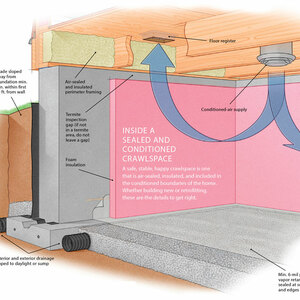In the past, I have helped my boss, a residential builder, install fiberglass batt insulation. Now, I have a chance to bid an entire job (all fiberglass batts in walls/floors, and blown-in fiberglass in attic). Three of us work together, one guy cuts, two install. We use a hammer-style stapler, wear long sleeve shirts, fill all holes with expanding foam, and go like mad. Does anyone have any tips about work habits and/or tools that they use to speed up and/or improve quality when installing batts and/or blown-in?
Any and all imput greatly appreciated!
ChrisA


















Replies
yes.. get rid of the fiberglass & switch to cellulose.. fiberglass is so close to a useless insulation that we never use it for anything besides blocking ..
we do 100% cellulose..
Mike Smith Rhode Island : Design / Build / Repair / Restore
Mike--
Asking a question out of ignorance: why is fiberglass "useless" as compared to cellulose? Does cellulose have a superior R value, prevent air infiltration better? Just asking...
Regards,
Rework
just my collection of thoughts here..
fiberglass fibers do not absorb moisture.. so if moisture gets into it .. it condenses on the fibers when they are below the dew point..
the condensation clumps together into droplets.. gravity pulls the droplets down and they rot out the framing where it collects....
air ( and moisture ) will readily pass thru fiberglass batts...open a wall and you will find collections of dirt in certain bays where air and dust have been passing thru for years..
batts ( especially kraft faced ) cannot be installed tight enough to the stud bays to prevent air bypassing at all of the joints.. so the R-value is degraded doubly at studs and plates.. the kraft to be effective, must be overlapped on the face of the stud.. drywallers don't like that so few do it...
when we were using F-glass, we used only friction fit batts and seperate poly-vapor barriers.. it's still a lousy air barrier.. and they still allow condensation of any vapor that gets thru..
F-glass is ok .. if there were nothing else available..but there is.. cellulose.. which is hydroscopic.. it will absorb moisture until it reaches the saturation point... since it almost never reaches that point unless there is an active leak.. it can later release the moisture when humidity conditions change...
a dens-pak install of cellulose will not have any voids .. and no air by-pass.. the true r-value will be acheived .. as opposed to the theoretical r-value of F-glass
here's the choices the average builder has...no insulation... f-glass... or cellulose..
the one that offers the best protection for insulation, fire protection and vermin control.. is ......... cellulose
but hey, whadda i no ?Mike Smith Rhode Island : Design / Build / Repair / Restore
Another reason is that cellulose's r-value doesn't change much with temp, whereas the greater the difference in temp (when your furnace is running flat out and you really need the insulation), the lower FG's r-value becomes. Also, cellulose is much more effective at blocking radiant transfer (like from your hot attic to your conditioned house in the summer) than is FG.
Cellulose is mostly recycled product, FG mostly isn't. Cellulose has a pest and fire retardant in it, FG doesn't.
I paid more to install cellulose in my house, and I still think it's the single best upgrade I made.Andy Engel, The Former Accidental Moderator
Mike:
Thank you. Knew there were good reasons behind your choice, just didn't know what they were...
Regards,
Rework
I'be been told, but haven't tried it, that one of those electric carving knives does a great job cutting fiberglass...
I hate working with the stuff. Make sure you wear a mask...your lungs will thank you.
Try out a powered mask instead of just the paper ones. Makes it a lot more pleasant to breath that way - Especially in hot weather.
Two cows were standing in a field. One cow said, "Moo". The other cow said, "Hey . . . I was going to say that."
Thanks guys. My choice would be cellulose too, but that's not my call to make with these houses. The one bit of advice my Dad gave was to get a really good respirator. I wasl also thinking about a rotory wheel cutter, the type my mother uses to cut cloth when she sews. Maybe its just me, but I hate cutting batts with a utility knife; maybe the rotary blade would cut through the entire batt with a cleaner, "one pass" cut.
ChrisA
when we were cutting batts we had "bolo" knives..sharpened on both sideswith about a 6" blade.. they'd cut batts & foam board tooMike Smith Rhode Island : Design / Build / Repair / Restore
and at the end of the day, shower with cool (or cold, if you're so inclined) water. hot water opens up the pores, and will let those *^*^%* fibers in and annoy you for days.
Another thing to do is use duct tape. Roll it back on it self so the sticky side is out and pat your exposed skin. removes most if not all those #$%^&^& fibers.
This is one of those times I would like to help but iI dont know what the tool is called, so a crude discription is all I got . It's a box knife with a shield that goes under the bottom from blade to the rear of the knife . When you run it across a fiberglass batt the shield pushes down on the batt allowing the knife to cut cleanly. They are realativily inexpensive and must be a good tool because two of them disappeared out of my truck after they were first used . Reminded me to buy some more .
Are they not the same thing as the quilters use to cut material?? Ask threads.
I would gt a large knife like mike smith mentioned.
Peace Pot Microdot
I went to HD & Lowes checked what it would cost to insulate my new house if I done the installing. Also had 2 insulation companies quote a price to do the complete job. Well the prices came out the be about the same. Are these guys installing at cost or HD & Lowes getting big profits of selling insulation?
Are you sure you're comparing the same things? I've run across the same question a time or 2, but the comparisons weren't accurate.
The times I've run across it, the homeowner was talking about putting batts in the attic, and the insulation contractor was going to use blown-in. (Which is cheaper)
I'm not an expert on the subject, but I've run across that scenario more than once.
Early bird gets the worm, but the second mouse gets the cheese.
Just my 2 cents worth but if you don't go with the more expensive respirators, sticking to the much more economical "paper" masks, at least get a major brand name with an exhaust valve and two straps. The exhaust valve makes breathing much more comfortable. Both features are well worth the extra money and the better masks last much longer. I store mine in a plastic box made to hold 3x5 cards, about $2.50 at Walmart. It keeps them clean and uncrushed between jobs.